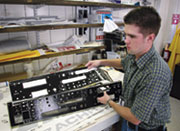...notes that engine designers program ECMs to calculate a performance-curve map that helps the engine "decide" how to achieve "peak emissions efficiency."
 |
| BACKFILL Equipment managers are using real-time performance information to reinforce procurement and maintenance decisions. (Photo by 5R Constructors) |
Information Arrival
Whether the end goal is performance, fuel economy or long life, the pressure to innovate beyond emissions cuts is forcing manufacturers to improve life-cycle operating costs for construction equipment owners. And that is exactly where equipment managers expect to see the benefits of the new electronic controls with reams of data available for downloading to a laptop or PDA. "The reality is that if you can expedite diagnostics and repairs to get a machine back into operation quickly, thats a huge benefit," says Zachrys Mike Monnot. He uses freed up time and money to research other equipment, such as an inflatable fishing light that he is using on night-paving projects to cover more square feet and reduce glare.
As usual, new technology also brings new problems. "Taking all the data and doing something useful with it is easier said than done," says Richard LeFrancois, a technology consultant and partner of Equipment Maintenance Innovators, Morrison, Colo. For many firms, the big hurdle is the "data-to-information game," according to Rick Juster, a former United Air Lines procurement chief and the newly appointed vice president of assets and planning for NES Rentals Inc., Chicago. "We all have a lot of data. The challenge is to convert it to useful information," he says.
In a bitter fight to reap market share, equipment manufacturers are starting, albeit slowly, to help contractors gather and analyze machine run-time information. For example, Deere & Co., Moline, Ill., is getting deeply entrenched in the data business, as is its next-door neighbor, Caterpillar Inc., Peoria, Ill.
Both companies and others constantly are working on ways to reduce owning and operating costs and data management is the biggest tool on the horizon. On July 27, Deere previewed 10 new machines it plans to launch at next years ConExpo-Con/Agg show in Las Vegas. After discussing the units service capabilities, product managers also showed off two privately labeled service add-ons, including a new oil analysis and filtration field caddy that retails at $7,000. "It is like dialysis for your machine," said Amy Asselin, a technical specialist for Deere.
 |
| BRIGHT IDEA Fishing lights help Zachrys nighttime paving. (Photo above and bottom by Tudor Hampton for ENR) |
Aside from continuing labor struggles and the launch of a new remanufacturing and certification program for used equipment, the bulk of the news in Peoria has been engine technology. Last month, Cat announced that it was the first off-road producer to receive EPA certification for an entire lineup of January 2005-compliant engines the result of $500 million in research and 250 new patents. Cat says the computerized units hit the market this fall and promise fuel efficiency. However, only "time will tell," says one owner.
The recent efforts of Deere, Cat and many others show the awareness U.S. manufacturers have of how important run-time data is to construction equipment managers. "Dealers and manufacturers are playing a much greater role," says Virginia Techs Vorster. Likewise, "Manufacturers are more interested in finding out what we need," says Markey.
As much as Mike Monnot is excited about the visibility he already is getting into his machines components and life-cycle performance, he is troubled by a lack of information-sharing by manufacturers to owners. "Some of the major manufacturers feel that the data is not yours, even though it is your piece of equipment," he says. "I should be able to download the data and access it wirelessly if I want to." Instead, when he reads an error code on some pieces of equipment, he must call a dealers field technician to the jobsite to decode the error and translate it into a useful diagnostic message.
That gets expensive for the firm, especially as dealers charge on average $75 to $80 per hour plus travel expenses, Monnot says. But some U.S. and European manufacturers recently have opened up fault-code values on machines in favor of an Internet portal and monthly access fee for self-diagnostics. "Thats the way it should be," says Monnot, who believes that most major manufacturers will be forced by their customers to open up code values over the next three to four years.
 |
| HANDS ON. AMECO databases, then repairs tools. |
Paperless Maintenance
Markey says equipment managers are driven to make equipment run safely and productively. But they have a natural "aversion to paperwork," says Pat Monnot, who has thousands of AMECOs small tools barcoded and databased on a central server.
One of the benefits of equipment data is the ability to store it in a central corporate database where the information is plugged into the firms enterprise software. Real-time equipment data from the field can help supplement project management, procurement, accounting, payroll, work orders, routine maintenance schedules and warranties.  click here to view chart
click here to view chart
 |
| STICKY In-house decal shop helps machines residual value. |
"The future is shoving data from a central location to people who are decentralized in the field" and vice versa, says Le Francois. Mike Monnot agrees: "All the things that we used to guess at we can now prove." One way he uses databases is to print his own decals for machinery, saving time and cost while increasing Zachrys brand and preserving the residual value of machines.
Still, Mike Monnots biggest frustration is reducing paperwork associated with work orders. LeFrancois sees an eventual 75% reduction, but thinks that the cost of eliminating the last 25% will be too high.
Software firms that offer cross-brand equipment tracking and other tools also are working to integrate their software into machines. They want to help owners...



Post a comment to this article
Report Abusive Comment